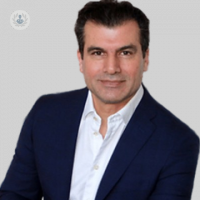Breast reduction surgery: 5 things you need to know
Escrito por:The ideal female breast varies widely across cultures, trends, and individual preferences, with no single definition. While Western ideals often emphasise larger breasts, a growing number of women seek breast reduction due to discomfort or dissatisfaction with overly large breasts. For many, large breasts can cause physical pain—such as back, neck, and shoulder strain—or psychological distress, often drawing unwanted attention and limiting clothing choices, social interactions, and physical activities.
Breast reduction surgery helps women achieve physical relief and emotional balance, allowing them to feel more confident and comfortable. This procedure often leads to immediate relief from physical discomfort, improved posture, and greater freedom in lifestyle and activities, like sports. However, choosing this surgery is a significant decision.
Renowned plastic surgeon Mr Allen Rezai stresses the importance of thorough consultation, where patients learn about both the benefits and potential risks. He advises women to fully understand the procedure to ensure they are prepared and confident in their choice.

Limitation on size-reduction
Having extra weight on your chest can lead to both physical and psychological challenges, and many people assume they can reduce breast size to any extent they wish. However, this isn’t always possible. While it’s helpful to have a desired size in mind and discuss it with your surgeon, there are limits to how much tissue can be safely removed without risking complications. The key is to focus on creating breasts that are symmetrical, well-balanced, and in proportion to your body frame.
There’s more than one type of incision
Breast reduction surgery offers various incision options, each suited to different needs. The type of incision depends primarily on how much reduction is required. For small reductions in patients with mostly fatty tissue, minimal skin excess, and good skin elasticity, liposuction alone may be sufficient. However, for those needing more tissue and skin removed, a lollipop incision, which leaves a scar around the areola and vertically to the breast crease, may be necessary. For significant reductions, an anchor or inverted T incision adds a scar along the breast fold for greater reshaping.
It’s essential to discuss incision options thoroughly during consultations to find the approach that best meets your goals. Consulting with multiple experienced plastic surgeons can help clarify the reasoning behind each option. Take time to research and ask questions until you feel fully informed and confident in your decision.
You may not be able to breastfeed
The effect of breast reduction surgery on breastfeeding ability depends largely on the extent of the procedure. During surgery, breast tissue is removed, and the nipple and areola are repositioned, which may damage or reduce milk ducts, potentially decreasing milk production and making breastfeeding more challenging.
I often discuss with patients the option of delaying surgery until they are certain their family is complete. This is not only because of potential breastfeeding limitations but also because pregnancy and weight gain can change breast size, possibly leading to the need for additional surgery. However, many patients find the physical discomfort—such as neck and back pain—and the psychological strain of having large breasts overwhelming, and for them, the benefits of surgery often outweigh the potential downsides.
Optimal results happen with time
Recovery after breast reduction surgery varies greatly from person to person and is influenced by the extent of the procedure. Most people can return to work and resume normal daily activities within 10-14 days post-surgery. However, it's important to avoid strenuous activities, exercise, and heavy lifting until 6-8 weeks post-op, and only after receiving clearance from your surgeon.
As for results, it takes time for the breasts to settle into their final shape and position. The tissue requires time to heal and adjust, so while you’ll start to notice positive changes each week, the full results typically become apparent within six to twelve months. If scarring isn’t an issue, your incisions should fade into fine lines by around one-year post-surgery.
The need for future surgery depends on factors like age and life stage at the time of breast reduction. For those who undergo the procedure in their 20s or before completing their families, additional surgery may be needed in the future. Breast size and shape often change with pregnancy, breastfeeding, or significant weight fluctuations, and even hormonal shifts can sometimes cause noticeable increases in breast size.
Having realistic expectations
Breast reduction surgery can bring satisfaction, but it’s crucial to have realistic expectations and understand potential outcomes. Each person’s anatomy is unique, meaning that achieving “perfect” breasts as imagined may not be possible. Surgeons are limited in how much breast tissue can be removed safely, and after surgery, breasts will likely differ in shape and position from before. Scarring is also a factor; while scars generally heal into fine lines, some individuals, especially those prone to keloid or hypertrophic scars, may experience more pronounced scarring regardless of surgical skill or aftercare.
Before deciding on surgery, it's essential to set realistic goals, weighing the benefits and limitations. An open, thorough discussion with your surgeon about your expectations and how your breasts will change can help avoid disappointment, even in a successful surgery.
I recommend several steps:
- Begin by researching the treatment and defining what changes you seek, remaining open to potential limitations. Choose a board-certified surgeon experienced in breast surgery, and review genuine patient feedback. Schedule consultations with at least two or three surgeons to compare their approaches.
- Be transparent about your medical history and feel comfortable asking questions. Ensure your surgeon explains the treatment options available and why certain techniques are recommended, as plans should be tailored to individual anatomy and lifestyle. Research any implants offered, understanding the manufacturer’s track record and guarantees. Additionally, confirm the aftercare process, knowing who to contact for support if complications arise.
- Finally, take time to “cool off” before committing. Reflect on the full scope of the procedure, including safety considerations and potential risks, to make an informed decision about moving forward with breast reduction surgery.
If you are considering breast reduction and would like to book a consultation with Mr Rezai, simply visit his Top Doctors profile today.


